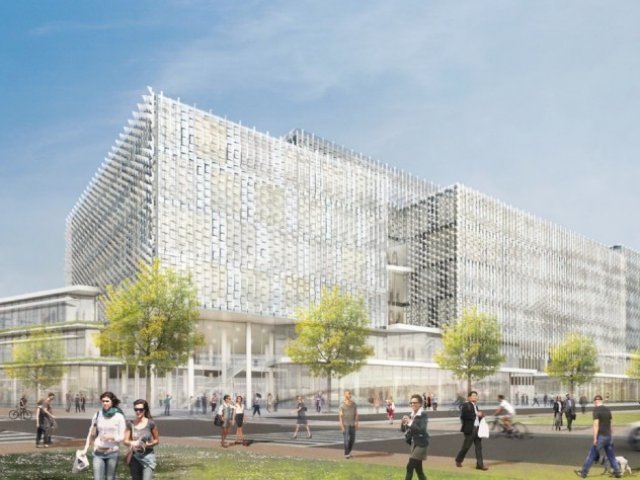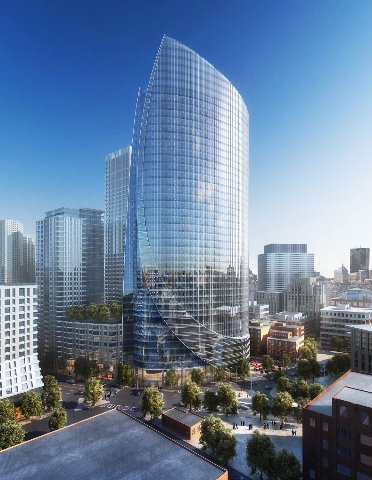A Renewed Boston Skyline
A Love of Geometry
By: Mark Favermann - Mar 10, 2023
Early on in their education, long before Euclid drew circles and triangles, most architects and urban designers had fallen in love with geometry, a branch of mathematics concerned with the shape of individual objects, spatial relationships among various objects, and the properties of surrounding space. That is also a description of architecture and urban design: the careers of the most successful designers have always focused on working and reworking geometry.
The last two decades of construction in Boston — in locations like the Seaport District, upper Boylston Street in the Fenway, and the Edge City on Guest Street in Brighton — have yielded mostly large groupings of uninspired, nondescript, and boring steel frame and curtain wall buildings. The occasional rare, odd piece or two are often quirky rather than original — even a bit visually distracting. But, over the past few years, a new approach to geometry has arrived.
Three examples of this new look to Boston’s skyline: Boston University’s Center for Computing and Data Sciences or “Jenga Building” near Kenmore Square; Harvard’s John A. Paulson Science and Applied Engineering and Applied Science (SEAS) Building in Allston; and the One Congress Street Building at the Bulfinch Triangle next to Government Center.
With the “Jenga Building” BU has finally found a strong visual statement for its campus. Touted to be the “greenest building” in Boston because of its zero-carbon footprint, the 19-storey structure looks like the wooden block-balancing, tower-tumbling Jenga game. It seems to look best from a distance — terrific from Memorial Drive across the Charles River — rather than close-up. It was conceived as a vertical sub-campus by its architects, Canadian-based KPMB: various stacked “neighborhoods” allow different departments to congregate and even collaborate across discrete precincts. Some BU students say the building reminds them of a stack of books.
Fulfilling BU president Robert Brown’s desire to create an iconic structure near the center of the school’s campus (though it is not a unique structural configuration), the Jenga Building has already become an instant Beantown landmark.
The first major piece in Harvard University’s Allston Campus master plan development, the John A. Paulson Science and Applied Engineering and Applied Science (SEAS) Building is the primary occupant of the 500,000+ square-foot Science and Engineering Complex (SEC). It features state-of-the-art classrooms, learning labs, maker space, faculty research labs, community space, and a café. Also, though the reasons for the claim are confounding (what is ultraclean bio-waste?), Harvard University insists that advanced green design methods make the building one of the most environmentally sustainable structures ever built.
This edifice houses the SEAS Bioengineering, Computer Science, Data Science, and Computational Science and Engineering programs, Electrical Engineering and Materials Science/Mechanical Engineering faculty, and most of the SEAS administrative offices. Nearby there are future plans for an expansive campus that will include — but not be limited to — lab and office space for technology and life science–focused startups as well as established mature companies, and market-rate housing. Among the projects coming soon: undergraduate and graduate dormitories and at least one hotel and conference center.
The architects drew on an uninspired structural form, but the SEC’s exterior envelope is a particularly interesting physical detail. The layered appearance of the complex’s exterior establishes a distinct identity, enhanced by how it minimizes energy consumption while maximizing natural light. Its patterned metal screen protects the interior from solar heat gain during warmer months while letting the sun enter during the winter, which reduces cooling and heating costs. The upper screen section provides natural light and ventilation to the interior spaces. Each of the custom panels is oriented relative to the sun, thus optimizing the enormous building’s energy efficiency and overall thermal performance.
Designed by the German architecture firm Behnisch Architekten to facilitate this sophisticated energy transfer, the structure is covered by a shiny mesh skin that’s made up of hundreds of triangular stainless-steel small fin elements fabricated by hydroforming. It is the product of 21st-century metal forming technology, which utilizes pressurized liquid media to generate well-defined shapes from tubular materials or sheet metals. The building looks better close-up than from a distance. Its articulated metal screen has inspired some to refer to the building as “The Cheese Grater.”
An easy stroll to Government Center on one side and to TD Garden on the other, One Congress Street is an elliptical 43-storey office tower that doesn’t look like any other structure in Boston. As described by project architects at Pelli, Clarke & Partners, the shape of the building is meant to suggest the look of a man’s overcoat being blown open by a strong breeze from nearby Boston Harbor. Developed by the HYM Investment Group, this visually theatrical ellipse-shaped edifice, made to fit snugly on its site, is highlighted by a bulky glass curtain wall that is broken up by long, elegant, curvy lines that suggest geological layers or shallow waves on a beach. The look is of a contemporary international sports trophy writ gigantic; its reflecting surface will serve as both a mirror and a beacon for other planned buildings at the former Government Center Garage complex.
Providing sweeping views of the harbor and beyond, the iconic tower’s sail-like form unfolds skyward in a series of gently tapering layers. This striking image, with its World Cup resonances, has become an immediate Boston architectural icon. One Congress Street is indeed a trophy of a building. Of course, in our post-Covid era, there is a pressing question: what does a Class A office building mean today in what has become our new working-remote normal?
Over the last half century or so, local nicknames for a number of Boston’s sometimes beloved and mostly hated architecture and urban design approaches have blossomed: The Pregnant Building (100 Federal Street); The Darth Vader Building (Boylston & Exeter Streets); The High Spine (shadows be damned, a skyscraper ridge of buildings from the Back Bay through the Financial District of Boston); The Urban Ring (a mythological, disconnected bus and subway route thought to bring blue collar workers living outside of Boston into the city); and The Allston Throat (a vehicle-congested viaduct area near Storrow Drive and the Charles River). It seems natural to now add The Jenga Building, The Cheese Grater, and The Trophy to the list.
These three new Boston buildings demonstrate how creative geometry can be both elegantly simple and somehow infinitely profound. Euclid would concur.
Reposted courtesy of Arts Fuse.



